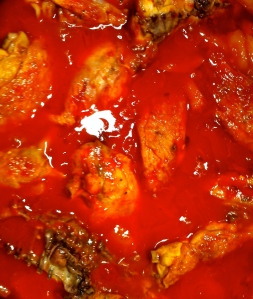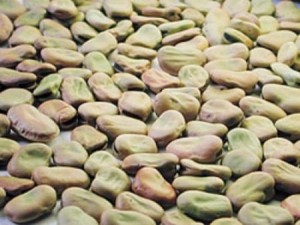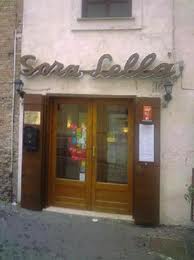Apologies to Sora Lella
Now that carnevale is over and we are immersed in the 40 sober, reflective days of quaresima (Lent), you would think that the excess of the Pugliese table would be significantly dialed back. But you would be wrong. Yes, the delightful chiacchiere carnival sweets are officially off the menu and there is a renewed observance of meatless Friday, but the butcher shops in Martina Franca seem just as busy as ever. Still, we’re seizing the moment to engage in some Lenten deprivation of our own if we are to hold our heads high at the beach this summer.
Mid-February through March finds us steering clear of red meat, dairy and all but especially miserly portions of pasta. Vegetables of every color have become the main event, with the judicious addition of fruit, particularly at breakfast. Beans like cannellini, fave, ceci and borlotti also figure prominently in our kitchen these days, serving as ballast in an ever-changing array of soups and vegetable-based stews. Extra virgin olive oil is still very much in evidence, but all other fats have been banished for the duration.
Far from feeling deprived, we’re developing a whole new palate, one that fairly explodes with flavor. From the subtle minerality of Swiss chard to the earthily bitter intrigue of cima di rape (broccoli rabe), there is no shortage of great taste on the menu. Maybe we’re even appreciating these subtle flavor distinctions more since none of their notes are masked by the unctuousness of animal fat. Still, on Sundays, we are still keen on the idea of Sunday pranzo, which seems a little sad without a reasonably substantial second course. In Martina Franca, the only appropriate contender is meat, and if you don’t like meat, you can have lamb. Yes, lamb.
Although there are plenty of pollerie (poultry stores) in town, we note that we have rarely seen chicken on a restaurant menu nor have we been served it in anyone’s home. We’re not sure why this is the case. It could have something to do with the notion that chicken featured heavily in the cucina povera (poverty cooking) of this area. No one wants to be reminded of those bad old days of deprivation, so now that the general level of prosperity here is considerably higher, meat and all of its cousins are the order of the day. Pugliese Sunday pranzo menus are an ode to meaty splendor, from braciole al ragu (veal rolls in long-cooked tomato sauce) to an assortment of ribs, sausages and cheese-stuffed dumplings cooked in wood-burning ovens all over town. So we’re going rogue with chicken.
Warming to the task, I just watched the most entertaining 1967 interview with the iconic Sora Lella in Rome forwarded by good friends Donna and Bob Chiarito. Sora Lella, the proprietor of a revered Roman restaurant of the same name, has been gone for 20 years, but her huge personality and influence live on. As you’ll see in the video, Sora Lella has no shortage of opinions about the appropriate use of gorgeous Italian red peppers and pollo nostrano (local chicken), particularly when it comes to a Roman standard called Pollo alla Romana. According to Sora Lella, there is no room for improvisation with this dish. When her interviewer hints at many wonderful recipe variations she might employ instead, Sora Lella’s inherently Roman character comes quickly to the fore. Watch the cleaver.

You can serve the sauce from Pollo alla Romana with penne rigate as a first course, followed by the chicken pieces.
Not without some trepidation, I like to fiddle around with this dish. The basic preparation method remains the same, but I tend to add rather more tomatoes to the braise so that I might serve the sauce with a toothsome penne rigate as a first course. Don’t tamper with the technique, though. The dish’s flavor rests on a careful and thorough browning of the chicken parts. In this, like Sora Lella, I am a purist.
Pollo alla Romana—Roman-Style Chicken with Peppers
Ingredients:
One onion, chopped
2 cloves garlic, peeled and finely chopped
4 Tbsp. (approx.) extra virgin olive oil
4 chicken quarters, skinned and chopped into smaller pieces (see Sora Lella’s cleaver technique in the video)
3 yellow and red peppers, cut into ½ strips lengthwise or 1” squares
1 can (28 oz.) best quality tomatoes, drained of liquid and roughly chopped
Small bunch of basil, chopped (in the summer); substitute with Italian parsley or marjoram in the winter
Method:
Remove the chicken from the refrigerator an hour or so before you need it. Salt it with Kosher or sea salt on all sides; leave on paper towels.
Add the olive oil to a large sauté pan with high sides. Blot the chicken pieces with paper towels and add to the olive oil. Brown over medium heat for at least 8-10 minutes per side until the chicken is a deep golden brown. Remove the chicken pieces to a shallow bowl or plate.
Add more olive oil to the pan if necessary, then add the onions. Saute the onions unti soft and translucent (about 15 minutes), but don’t allow them to brown. Add the peppers and garlic and sauté for another 10 minutes or so until the pepper begins to soften. Don’t let the garlic brown. Add a little water from time to time if the mixture looks too dry.

Lina is a particularly good brand of canned Italian tomatoes. During the winter, used canned rather than fresh tomatoes if you don’t have any of your own already preserved.
Add the chopped tomatoes and sauté with the onions and peppers for a few minutes until the mixture begins to simmer, then add the browned chicken pieces. Return to a simmer, then lower the heat. Allow the chicken and sauce to sauté for about half an hour or until the chicken is done and the peppers are soft. Sprinkle the basil (or parsley and marjoram) toward the end of the cooking time.
If serving pasta as a first course, prepare the pasta in the usual way. When the pasta is al dente (still firm to the bite at the core), drain the pasta in a colander, reserving about ½ to ¾ cup of the pasta cooking water. Add the tomato, onion and pepper sauce to the drained pasta, sprinkling a little of the pasta cooking water into the mixture to keep it creamy. Serve the pasta with freshly grated parmigiano or cacioricotta cheese.

Finished Pollo alla Romana. Use the sauce with pasta for a first course, then erve the chicken pieces as a second course.
Serve the chicken as a second course with a side dish of sautéed Swiss chard, spinach or kale sautéed in extra virgin olive oil with peperoncini (hot, little dried peppers, finely chopped) and garlic.
If you’re skipping the first course pasta, be sure to offer a crusty Pugliese bread to take advantage of the delicious pepper and tomato sauce.
Serves 4 with big appetites or 6 if you’re serving a first course, too.














Who takes the photos of the food and where do you get the food to photograph?
Hi, there! I take the photos while I’m cooking, which is challenging! If I were more conscientious, I would have a better camera, a flexible tripod, reflectors and a white balance filter. Other photos come from shots I’ve taken at the fresh fruit and vegetable market, restaurants, food shops, butchers (in this case) and in the country. I’ve sourced a few photos from the web, but you’ll notice which ones these are because they are usually attributed to the source. Hope you like them!